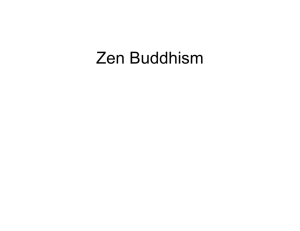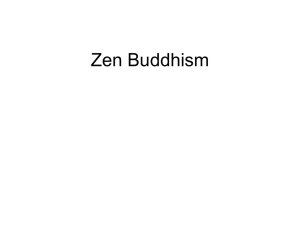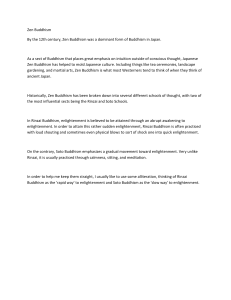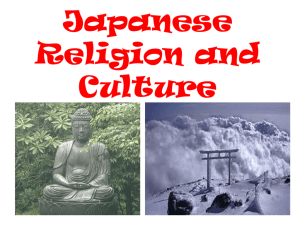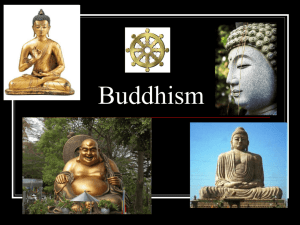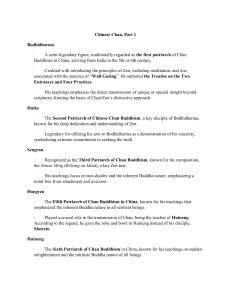Lecture 4 Zen Buddhism
advertisement
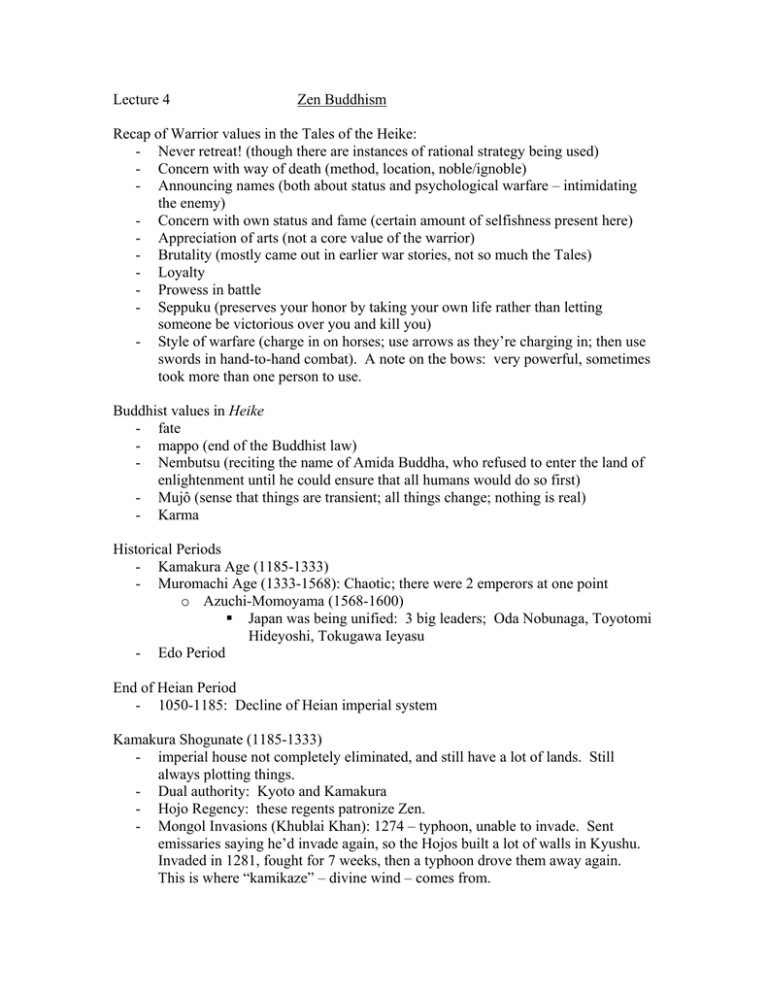
Lecture 4 Zen Buddhism Recap of Warrior values in the Tales of the Heike: - Never retreat! (though there are instances of rational strategy being used) - Concern with way of death (method, location, noble/ignoble) - Announcing names (both about status and psychological warfare – intimidating the enemy) - Concern with own status and fame (certain amount of selfishness present here) - Appreciation of arts (not a core value of the warrior) - Brutality (mostly came out in earlier war stories, not so much the Tales) - Loyalty - Prowess in battle - Seppuku (preserves your honor by taking your own life rather than letting someone be victorious over you and kill you) - Style of warfare (charge in on horses; use arrows as they’re charging in; then use swords in hand-to-hand combat). A note on the bows: very powerful, sometimes took more than one person to use. Buddhist values in Heike - fate - mappo (end of the Buddhist law) - Nembutsu (reciting the name of Amida Buddha, who refused to enter the land of enlightenment until he could ensure that all humans would do so first) - Mujô (sense that things are transient; all things change; nothing is real) - Karma Historical Periods - Kamakura Age (1185-1333) - Muromachi Age (1333-1568): Chaotic; there were 2 emperors at one point o Azuchi-Momoyama (1568-1600) Japan was being unified: 3 big leaders; Oda Nobunaga, Toyotomi Hideyoshi, Tokugawa Ieyasu - Edo Period End of Heian Period - 1050-1185: Decline of Heian imperial system Kamakura Shogunate (1185-1333) - imperial house not completely eliminated, and still have a lot of lands. Still always plotting things. - Dual authority: Kyoto and Kamakura - Hojo Regency: these regents patronize Zen. - Mongol Invasions (Khublai Khan): 1274 – typhoon, unable to invade. Sent emissaries saying he’d invade again, so the Hojos built a lot of walls in Kyushu. Invaded in 1281, fought for 7 weeks, then a typhoon drove them away again. This is where “kamikaze” – divine wind – comes from. - o Warriors not rewarded because the Hojos had already spent too much money on the defenses. Rise of large, independent provincial military governors. Imperial Uprisings 1324, 1331. Hojos send Ashikaga to crush them, but he sides with the emperors. Images: Mongols using incendiary devices on their arrows – surprised the Japanese. Next image is the fortifications built against the Mongols. Buddhism - Life is suffering, in the face of which humans are helpless. - Existence is transient and constantly changing; we’re always dependent on other things, there are constantly all these causes of events so we’re not always in control. How to get out of the cycle of suffering? - Blind desire is the root of illusion and suffering. - To rid yourself of desire, do various things; ultimately achieve enlightenment = freedom from attachments, desires. Buddhism in Kamakura Period - Tendai and Shingon: dominant sects. Very decadent; corrupt false monks (criminals posed as monks and extorted money from believers!). - New Buddhists: practice vs. faith; practice involves ascetic ritual. - “Pure Land Buddhism” – Amida Buddhism. Biggest proponents were Honen and Shinran; brought Buddhism to the poor and common people – Honen told them to just say the name of Amida Buddha over and over again to achieve enlightenment. Shinran told them you just have to say it once, not over and over. - Nichiren Buddhism: still sort of exist today. Based on reciting the Lotus Sutra. Believe that everyone has the potential to attain enlightenment through selfcultivation and reflection. Realization of the interconnectedness of things, and responsibility for not only individual self but wider world as well. Very fundamentalist; kind of like Japanese Jehovah’s Witnesses. Sokka gakkai – international organization today that is centered around Nichiren’s teachings. Has political power in Japan today. Key Concepts of Zen (discussion): - ideas behind meditation: clearing the mind, “making the mind flow”; this is a practice aimed towards achieving enlightenment o satori - intuition/understanding the nature of things and the nature of their being (“the isness of things”): Zen basically says that our usual ways of categorizing things is actually abstract rather than “real.” Instead of saying “A is B,” think “A is….” This leads into the idea of waiting; not waiting for anything in particular, just waiting. - Verbalism: exposes how language is misleading - Letting go of conscious thought and relying on intuition/physical knowledge or sense rather than intellectual knowledge and thought. - wabi/sabi: wabi – rustic simplicity (conceptual, interior; sabi – expressed in painting (practiced; exterior) How does this fit in with the way of the samurai? - both embrace death. In Zen, if you can embrace death, it’s easier to face and accept. - Being close to death means being in a state wherein you’re not thinking conceptually/intellectually. Video: training of a monk (“The Principles and Practice of Zen”) Paper guidelines: engage yourself with your material; you may view and reference other videos in addition to the assigned ones. “Throne of Blood” by Kurosawa might be a relevant additional film.
